Several owners of the Iveco Daily 4×4 in Australia have reported failures of their transfer gearbox. All these failures are due to the circlip within the transfer gearbox, failing to hold the high/low range gear cluster in place. The failure of the circlip allows the gear cluster to move out of position, the vehicle becomes undrivable and in many cases it also destroys the gearbox too. These gearboxes are not cheap to replace if they fail. They’re made in relatively small numbers and have not benefitted from the cost savings of large volume production, so they have a list price of over £9000 + VAT!! I have been aware of this potential issue for quite some time but have been reluctant to open up the transfer gearbox to carry out a modification because:-
- “If it ain’t broken don’t fix it”, why open a serviceable gearbox and potentially damage it when it is working fine for the time being?
- I am trying to keep the vehicle as ‘standard’ as possible for reliability and availability of spares; and
- Iveco manual/documentation is hideously poor quality and can’t be relied upon for accuracy. The Iveco workshop manual (which I bought new together with the new vehicle) is full of errors. e.g. the manual features the version of the transfer gear box that is previous to the one fitted in the truck (Iveco are on version 9 of the gearbox now) so I can’t be entirely sure how to disassemble/reassemble my version of the gearbox.
Luckily for me, Don (a fellow Iveco Daily 4×4 owner in Australia) decided that the risk of sudden catastrophic failure of his gearbox, was a risk too far for his remote bush operations. He therefore stripped-down his transfer gearbox to find a solution (see Don’s website for more information http://www.goingbush.com/iveco4.html ). We exchanged a few ideas on a suitable solution and decided the best option was to install a bracket that would prevent the circlip from coming out of its location groove by:
(a) stopping the ends of the circlip from being able to close together; and
(b) preventing the ends of the circlip lifting out of the groove.
Don has the luxury of doing the work in his rather nice workshop with access to a very handy array of tools, including a milling machine. He has also taken the opportunity to address a few of the other short comings of the gearbox that I will not be tackling and will just have to live with (again see his website for full details).
From my research using the workshop manual and looking at the parts catalogue, I thought that it would be possible to disassemble the rear half of the gearbox while it was still installed in the vehicle. This would greatly simplify the job for me, doing it whilst on the road without proper workshop facilities. Following his experience of stripping the gearbox in his workshop, Don confirmed that my idea should be possible, which gave me my ‘green light’ to attempt the modification myself in a campsite!
These are the steps I took:
(i) drain the oil and remove the rear axle prop-shaft and PTO unit (connecting the electro retarder to the gearbox).
(ii) removed the PTO gear from the primary input-shaft, then used a couple of bolts and large washers to hold the high/low range gear clusters bearing in place.
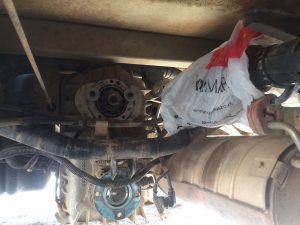
PTO and prop-shaft removed
(iii) removed all the bolts from the rear chassis cross member support. I didn’t remove the cross member completely as I was concerned it could be difficult to put back between the chassis rails. With all its bolts removed, it could be moved enough to allow the rear casing to be removed.
(iv) put a strap around the front half of the gearbox and secured it tightly against the upper chassis cross member to prevent any movement of the front half casing while removing the rear.
(v) removed all the nuts holding the transfer casing halves together but left the bolts in place to support the front half (there are 3 bolts across the top and one on the left side that don’t have nuts, they screw into the casing and these were removed completely).
(vi) The casing was very securely ‘glued’ on by the gasket sealant and required the gentle use of a chisel on one corner to separate the rear casing from the centre frame.
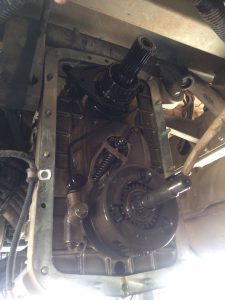
Rear case removed!
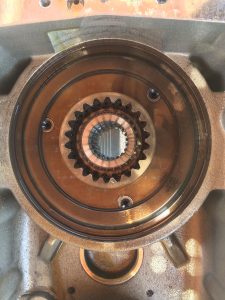
High/Low range gear cluster
The photo above shows the high/low gear cluster with its thrust plate held in place by the circlip; below with the circlip and thrust plate removed, the very shallow circlip groove can be seen. The groove is less than 1.4 mm deep, no wonder these circlips can ‘jump out’ and destroy the gearbox!!!
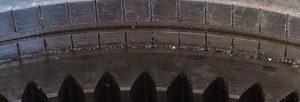
Shallow circlip groove
I set about fabricating a bracket in two pieces out of some angle iron. The first piece is shaped to sit against the curved casing and has a lip to fit between the ends of the circlip which will prevent them from closing together (there is a small amount of play to allow for thermal expansion of the circlip). The second piece fits on top of the first piece, to hold the ends of the circlip down into the groove; it is also shaped to clear the thrust plate. Given better materials and tools this could easily be fabricated in one piece, but I’m doing the job in a campsite using the tools I carry with me. It took a lot of filing!!
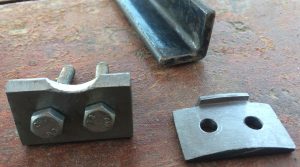
Circlip bracket
In the photo below you can see the two holes I have drilled through the casing to secure the bracket in place. Note the holes are not centred on the casing. This off-centre arrangement is to avoid:
– an oil gallery coming from the central frame of the gearbox that feeds the gear cluster and the PTO (you can see the oil gallery just to the left of the locating dowel in the photo below) and
– the ridge on the outside of the casing. This is for one of the casing bolts to screw into and I wanted a flat surface for the nuts to be attached. You can see the hole for the bolt in the photo below to the right of the dowel peg.
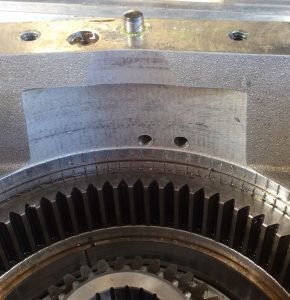
Bracket holes
The casing at this point is approximately 15 mm thick and so could be tapped for the bolts to screw into. However, given I am doing the modification ‘in the field’ I decided to keep it simple, so I drilled all the way through and used nuts. The bracket is installed at the top of the gearbox, which will have minimal exposure to oil and so an oil leak is unlikely.
The photo below shows the bracket installed.

Bracket installed
The gearbox was then reassembled. The whole job was done in a day and I am now happy that I have a much lower risk of the circlip failing and the gear cluster moving out of position and destroying the gearbox!
Hey… was this useful? If so, you might like to support our website costs with a donation below. Thanks 😊👍
